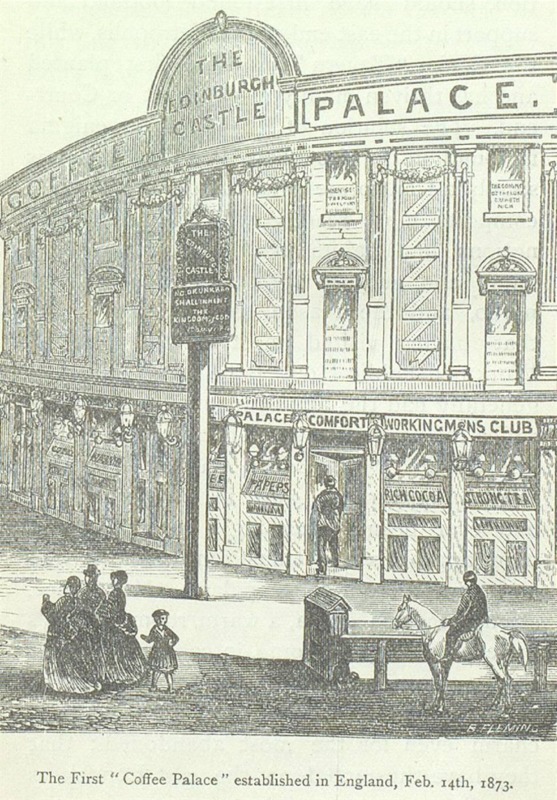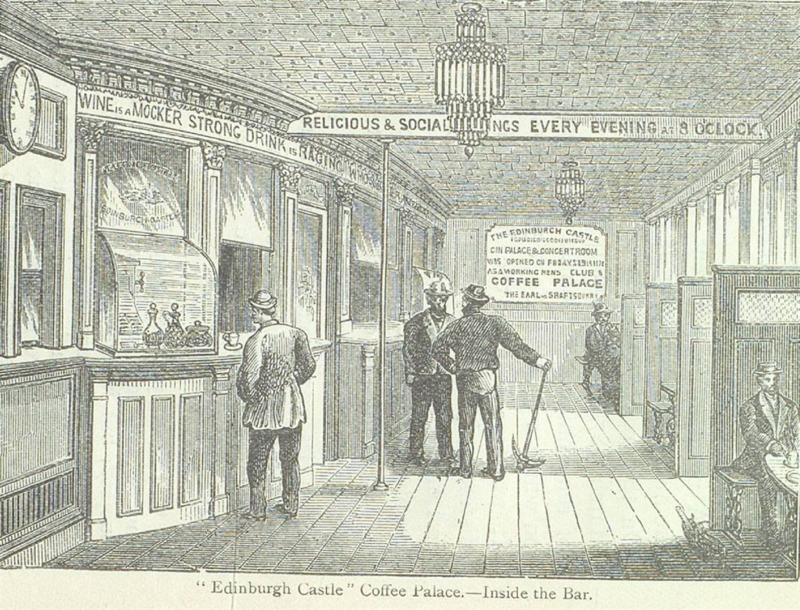The Decline of the Coffeehouse (1830-1900)
Similar to the early days of the coffeehouse, art depicting the coffeehouse during its decline portrayed the space as closed off to women. In this drawing, "The First Coffee Palace Established in England," the Edinburgh Coffee Palace is shown from the outside. The building is advertised on the outside for comfort, cocoa, papers, and tea. A different sign says that it is a "workingman’s club". A group of three women walk by and ignore the building. A little girl lags behind the group of women to look behind them at the coffeehouse. One man enters the coffeehouse, while the other stays on a horse. The artist of this drawing is not available in the database. This image was used in the book Coffee Taverns, Cocoa Houses, and Coffee Palaces: Their Rise, Progress and Prospects; with a Directory by E. Hepple Hall. This author has faded from history or it is not within my means to find information on him. The women in this picture are ignoring the coffeehouse and walking in the opposite direction from the entrance to the building. This is most likely done to subtly advertise the people who were being targeted to visit the Coffee Palace. William H. Ukers, the founder of The Tea and Coffee Trade Journal, wrote that the coffee palace was an attempt to make the coffeehouse more popular by revamping it into “a place of resort for working men” (Ukers 76).
This drawing, "Inside the Bar of the "Edinburgh Castle" Coffee Palace", shows three men in similar hats and coats are standing, while others are sitting in booths and drinking coffee. During the coffeehouse’s decline, men were less inclined to converse with each other and were more inclined to read their newspapers in isolation (Ukers 76). This is the reason why the men in this drawing are sitting so far apart at their tables. Two of the men who are standing are talking to each other and one man is leaning on a pickaxe. The pickaxe is most likely included to show that the man is a laborer and is a "working man". The third man who is standing is waiting for his coffee at the window of the bar. The artist is not available in the database. This image was paired with the prior image in the book Coffee Taverns, Cocoa Houses, and Coffee Palaces: Their Rise, Progress and Prospects; with a Directory by E. Hepple Hall.
These drawings are designed to attract male viewers by showing them how the coffeehouse is for men only. Women and children are shown to have no place and/or no interest in a masculine space. The coffeehouse returned to its original premise as a place for men to do masculine activities together. Putting the men and women in different groups in the drawing emphasizes the masculinity and femininity of each. They are portrayed as unequivocally different and held to different social standards.
Although these advertisements for the coffee palace tried to appeal to men, the sociability of the coffeehouse began to disappear and slowly the coffeehouses were replaced by exclusive men’s clubs (Ukers 76). To be a member of these clubs, men had to pay exorbitant subscription fees and had to be a member of the aristocracy (White). New ways of obtaining news through home-delivered newspapers ended the coffeehouse’s monopoly on information (White). As a result, the coffeehouse was no more.


